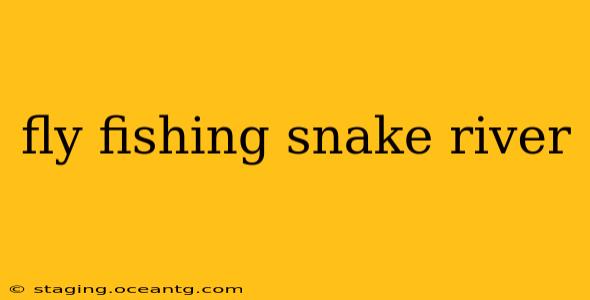The Snake River, a sprawling waterway carving its path through Idaho, Wyoming, Oregon, and Washington, is a fly fishing paradise renowned for its diverse fish populations and stunning landscapes. From its headwaters in Yellowstone National Park to its confluence with the Columbia River, the Snake offers a multitude of fishing opportunities, catering to both seasoned anglers and enthusiastic beginners. This guide delves into the intricacies of fly fishing the Snake River, covering everything from prime fishing locations and techniques to the best time to visit and essential gear.
Where to Fly Fish on the Snake River
The Snake River’s vastness necessitates focusing on specific sections. Each stretch boasts unique characteristics and fish species. Here are some of the most popular and productive areas:
-
The Henry’s Fork (Idaho): Known for its legendary dry fly fishing, the Henry’s Fork is a blue-ribbon trout stream teeming with large, wild rainbow and cutthroat trout. Its crystal-clear waters and challenging currents make for an unforgettable angling experience.
-
The South Fork (Idaho): This section of the Snake River offers a mix of fast-flowing riffles and calmer pools, supporting populations of rainbow, brown, and cutthroat trout. It's a great option for anglers seeking diverse fishing opportunities.
-
The Middle Snake (Idaho): A broader, slower-moving section of the river, the Middle Snake is known for its excellent fishing for both trout and bass. It's a more accessible area, making it ideal for beginners.
-
The Lower Snake (Oregon/Washington): This section is known for its steelhead and salmon runs, particularly during the fall. It's a different kind of fly fishing experience, demanding more robust gear and techniques.
What Flies Work Best on the Snake River?
Fly selection varies greatly depending on the time of year, specific location, and the target species. However, some consistently productive patterns include:
-
Dry Flies: Parachute Adams, Elk Hair Caddis, Stimulators, and various mayfly imitations are staples for trout fishing.
-
Nymphs: Prince Nymphs, Pheasant Tails, and Copper Johns are effective patterns for subsurface fishing.
-
Streamers: Larger streamers like articulated patterns are effective for targeting larger trout and steelhead.
Choosing the right fly often involves observing the river's insect life and matching the hatch. A knowledgeable local guide can significantly enhance your success.
What is the best time of year to fly fish the Snake River?
The ideal time to fly fish the Snake River depends on the specific section and target species. Generally, the best fishing occurs during the spring and fall months when water temperatures are optimal, and insect hatches are abundant. Summer can be productive, but higher water temperatures can make fishing more challenging. Winter fishing can be good in certain areas, but it usually requires specialized techniques.
What kind of fish are in the Snake River?
The Snake River boasts a diverse array of fish species, including:
- Rainbow Trout: A ubiquitous species found throughout the river system.
- Cutthroat Trout: Native to the Snake River basin, they are prized for their beauty and fighting spirit.
- Brown Trout: Introduced to the Snake River, they've established thriving populations in many areas.
- Steelhead: Anadromous fish migrating from the ocean to spawn in the river.
- Salmon (certain areas): Chinook, Sockeye, and other salmon species can be found in the lower Snake River.
What gear do I need for fly fishing the Snake River?
Essential gear includes a suitable fly rod (typically a 5-weight to 8-weight), reel, fly line, leader, tippet, a selection of flies, waders, and appropriate clothing. Consider also bringing polarized sunglasses, insect repellent, sunscreen, and a net.
Are there any guided fly fishing trips available on the Snake River?
Yes, numerous guides and outfitters offer guided fly fishing trips on various sections of the Snake River. Guided trips can be invaluable, especially for those unfamiliar with the river or its nuances. They provide access to prime fishing spots, expert advice, and a hassle-free experience.
What are the regulations for fly fishing the Snake River?
Fishing regulations vary depending on the specific location within the Snake River system. It's crucial to obtain a fishing license and familiarize yourself with all applicable regulations, including size and bag limits, before heading out. These regulations are often available online through state fish and wildlife agencies.
This comprehensive guide offers a solid foundation for planning your Snake River fly fishing adventure. Remember to always practice responsible fishing, respect the environment, and adhere to all regulations. Tight lines!
